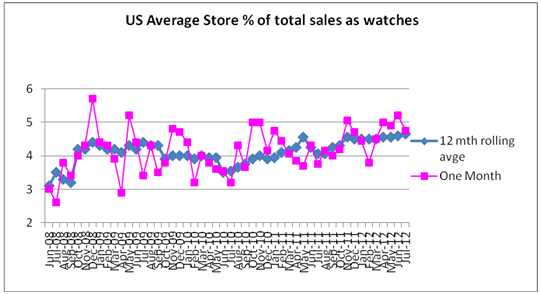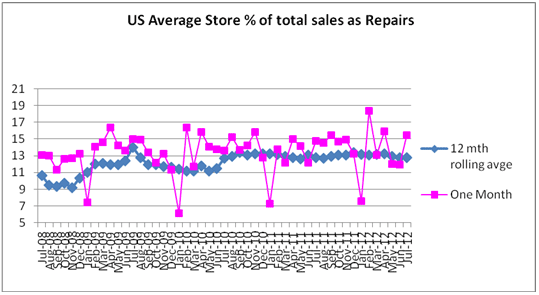
David Brown: Watches and Repairs
BY DAVID BROWN

Published in the October 2012 issue
Sometimes it’s interesting to compare the performance of the lower profile departments within a store’s sales figures, and this month we are going to hone in on two – repairs and watches.
One of the interesting comparisons in our monthly store data samples is the contrast between larger stores, who do over $1 million a year in sales, and smaller stores with sales below this level.
When we delve deeper into the numbers there are two areas for which the contrasts in performance are quite noticeable. These are two departments that we often don’t discuss in this column but perhaps signify some of the key differences between those stores doing higher sales and those that don’t.

Advertisement
As the graph shows, watch sales have contributed to the growth in sales for stores overall since July 2010, increasing from around 3.5 percent of total store sales to 4.6 percent of total sales on an annualized basis.
Watches have been a traditional seller for jewelry stores forever and, can be either a significant contributor or a less prominent part of the overall sales mix, often depending on whether the store owner is a watchmaker or jeweler by trade. While looking at our data this month however, it is interesting to note that watches, as a percentage of sales for larger stores, are significantly higher than for stores with sales under $1 million.
For larger stores over $1 million, the typical store is achieving 6.8 percent of total sales via watches – however when we contrast these results for stores that are doing less than $1 million on sales, we find that the typical smaller store is achieving just 2.5 percent of annual sales figures from watch sales -a significant difference, and one that has been a common trend for quite some time.
It raises the question why? An obvious answer may be a greater selection of inventory and brands in bigger stores that is contributing to this result. It may also be likely that given watches are a commodity that is easily comparable and price shopped, many customers will go to a larger store where they feel the buying power and prices will be more competitive.
If this is true it emphasizes that for the smaller jewelry store a point of difference in selection and service is all the more important if they wish to attract more customers to their store.
The other area of interesting contrast between larger and smaller stores is repairs.
Advertisement

As the figures show, repairs, as a percentage of annual store sales, did increase during the worst of the global financial crisis; however they appear to have leveled out over the last 2 years, contributing around 13 percent to the typical store’s total annual sales.
This time the numbers tend to favor smaller stores. Stores over $1 million in sales are achieving around 10 percent of their total store sales as repairs. Contrast this with stores under $1 million and the percentage contribution increases to 15.3 percent. These figures will be affected by the smaller repair style jeweler who tends to focus more on this part of their operation and less on new sales. Repairs have always been a traditional mainstay for smaller stores and these numbers are not surprising.
The issue for smaller stores is how to turn this traditional repair traffic into customers who are ready to buy. There are a number of ways that this can be implemented:
- Offer a voucher on sales with every repair collected. A voucher for a dollar or percentage saving on their next purchase will reward those loyal repair customers and remind them of the inventory you have in the store. Make sure you include a time limit to prompt action and, if possible, a follow-up before the voucher expires.
- Display good selling inventory en route to your repair area. If customers tend to come to one part of the store to drop off and pick up repairs then make sure that temptation is laid in their way! Have some of your best selling spontaneous purchases for them to view while they wait.
- Get the staff onboard. Make sure that customers have product shown to them. This may be a simple “We just got this in today, what do you think of it?” Sometimes a little suggestion can be enough to get the ball rolling
- Follow up on the unsuccessful quotes. If the customer isn’t going ahead on a repair do they need a new one to replace it? The most obvious area for this is watches. Again it’s about planting the seed – often a little suggestion can get them to think about it. McDonalds’s has made a fortune from asking “Do you want fries with that?” The principle is the same in your store.
Repairs can be a profitable part of any jewelry business. They can become even more profitable if you can harness the traffic into buying customers as well.
About the Author: David Brown is President of the Edge Retail Academy, an organization devoted to the ongoing measurement and growth of jewelry store performance and profitability. For further information about the Academy’s management mentoring and industry benchmarking reports email to inquiries@edgeretailacademy.com or Phone toll free (877) 5698657 Edge Retail Academy, 1983 Oliver Springs Street Henderson NV 89052-8502, USA
Advertisement